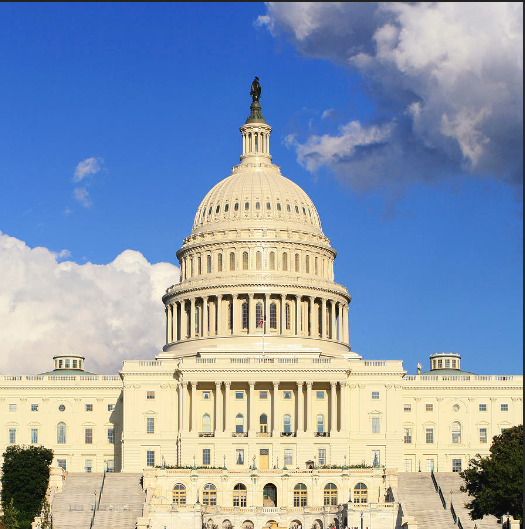Blog Layout
NAWB Calls on Biden Administration to Strengthen Workforce Development

With President-elect Biden taking office next week and the 117th Congress in full swing, NAWB felt it important to make it clear to all sectors of government what is necessary to strengthen the federal workforce system. In a detailed letter NAWB has outlined how both the Biden Administration and Congress can act to ensure local workforce development boards are able to best serve their communities. This letter describes what NAWB members and stakeholders have deemed necessary to help the American economy and job seeker alike. The full letter text is included below, and has been sent to the appropriate parties mentioned above. NAWB welcomes the opportunity to work with President-elect Biden and Congress to advance workforce development programs in the United States.
Dear President-elect Biden:
The National Association of Workforce Boards (NAWB) represents over 500 local Workforce Development Boards (WDBs) across the country. NAWB, WDBs, and the Biden Administration share the same goal: to build back America and the American public workforce system, which will make our country stronger as a result.
WDBs serve as the primary link between the U.S. Department of Labor (DOL), other federal and state agencies, education institutions, local elected officials, community organizations, and employers and the workforce. As the United States continues to grapple with the economic devastation caused by COVID-19, millions of Americans remain out of work and in need of new skills to find employment. Many previously held jobs that are not coming back. At the same time, it is estimated that only 10-to-20 percent of adults receive adequate skills development for sustainable employment.
As mentioned on the Build Back Better initiative’s website, communities of color are experiencing disproportionate rates of unemployment in addition to other repercussions caused by COVID-19 and are especially in need of significant skills development and job placement. Meanwhile, the nation’s economy continues to shift to Industry 4.0 with changing skill needs, a shift which has accelerated due to the pandemic. WDBs help unemployed and under-employed Americans acquire these skills needed by employers and find placement in new employment but are overwhelmed by current demand and limited resources caused by the pandemic and long-term underinvestment. WDBs can also help incumbent workers acquire these skills to enable them to retain employment.
In the five years since President Obama signed the bipartisan Workforce Innovation and Opportunity Act (WIOA) into law, and in many states, for many years prior to that, WDBs led by locally appointed business volunteers have identified and developed proficiencies for implementing WIOA. These proficiencies include coordinating with regional stakeholders and partners such as employers, community colleges and the public K-12 education system to develop and implement employer-driven solutions, analyzing and applying critical data to make informed decisions how to leverage and spend public funds to best serve their regions’ economic, employer and worker needs and developing and deploying work-based learning strategies including a focus on registered apprenticeships. During and in response to the pandemic, WDBs converted many services to virtual delivery and employed other new strategies to continue to work with employers and job seekers uninterrupted.
Considering all this, NAWB believes that the best resources for the Build Back Better initiative are the WDBs across the country, who can efficiently identify regional economic and employer needs, along with the skills needed to provide safe and sustainable workplaces.
NAWB suggests the following considerations for the Biden Administration’s Build Back Better initiative:
Seek to reauthorize and update WIOA (WIOA 2.0) and bring the American workforce into the future. To quote the Build Back Better initiative: “Even before COVID-19, too many families were struggling to make ends meet and too many parents were worried about the economic future for their children.” NAWB agrees and believes reinvesting in the workforce of today and tomorrow can help provide a more secure future for Americans everywhere. This includes:
• Updating and re-enacting WIOA to fit current and future labor market conditions and skill requirements, which will give more Americans an equal chance to get ahead; and,
• Assessing and addressing the consequences of long-term unemployment and dislocated workers, which have increased significantly as a result of COVID-19.
Increase transparency in data and aligning it with expected outcomes for the Federal investment in employment and training. This transparency will help the Biden Administration address inequalities in the public workforce system and continue to invest in effective workforce development programs. This includes:
• Investing in technology to ensure timely release of data for use in managing investments, and impact analysis for demographic data to ensure equity in service and results; and
• Keeping WIOA outcomes and services data publicly available.
Embracing the understanding that the U.S. labor market is dynamic, and meeting employers’ present and future skills needs is critical to implementing the Biden Administration’s robust jobs agenda:
• The number of hires, voluntary or involuntary separations (quits/layoffs), and job vacancies in a single year total over 100M transactions. Even during the pandemic, in August 2020 5.9M hires, 4.7M separations and 6.9M vacancies were recorded. Tracking these transactions and adding context for regional labor markets is a key part of a WDB’s work
• Labor force participation rates are falling
• People are working to later ages, partly out of interest in staying employed and partly out of economic necessity. We will continue to need these older workers as U.S. birth rates are falling and slowed immigration will shrink the available labor force.
• Incumbent workers, and their access to skill development, is imperative as nearly 80 percent of the labor force the US will rely on in 2030 is in the current labor force.
• Local matters even more as Census data show we do not have the mobility we think we do in the U.S. Census data tells us 9.8 percent of Americans moved between March 2018 and March 2019, and younger worker moves dropped from 29 percent in the 2005/2006 study to 20 percent in the 2018/2019 study. Taking a new job was the third-highest reason to move, behind family situation and moving closer to current work, the first and second-highest reasons to move.
• Not only is analysis of these trends and transactions in a region important, but so is the broader look at other systems that have significant impact, such as housing, transportation, childcare, the education infrastructure and the skill needs of the local businesses involved. Each of these can be significantly different from region to region.
• WDBs’ partnerships with business help identify the region’s critical skills, and through the WDBs’ networks of American Job Centers, learning providers and community/faith-based organizations as well as an increasing online presence, allows WDBs to effectively connect with employers and workers to provide current skills assessments, options for career advancement by helping focus their efforts on critically needed skills, support assistance for life issues, and connections to current vacancies.
Building sustainable resources to support communities. A one-time investment in workforce development does not allow for adaptability in an ever-changing environment. This includes:
• Increasing and modifying funding for short-term and long-term skill-based training. Increases WIOA funding can easily be used for short-term skill-based training. Building more capacity into WIOA to achieve short-term upskilling and reskilling and effectively bridging the life-long learning career planning and preparation that will be essential for workers makes sense, in part because WDBs are focused on outcomes critical to their region.
• Through WIOA, WDBs can quickly implement skilling needs. Any increase in funding to WIOA can be quickly distributed making effective investments in critical skills and industries in short order. Also, since WDBs’ infrastructure of local outreach and engagement is already in place and funded, such as the network of American Job Centers, each additional dollar to WIOA realizes more one-to-one counseling and skill development.
• NAWB recommends an additional $6,600,000,000 over five (5) years, in funding to assist with skills development to address the loss of jobs caused by automation. NAWB also recommends adequate annual funding for skills development and dislocated workers due to COVID-19.
• Confirming the authority of local WDBs for the allocation of WIOA funds based on their determination of needs in their region, consistent with the allowed use of WIOA funds as detailed in the Act.
• Investing in reliable/high-speed broadband accessibility must continue to be a high priority for Congress and the Administration, as few issues pose as large a barrier to the skilling/re-skilling/upskilling efforts for the U.S. labor force as the lack of access to reliable broadband
The National Association of Workforce Boards is eager to continue engagement with the Biden Administration and is ready to help America build back better.

By Stacy Heit
•
12 Dec, 2023
NAWB responded to the latest WIOA reauthorization proposal on Dec. 12, 2023, in a letter addressed to the chair and ranking member of the House Education and the Workforce Committee. Read the full letter below. Dear Chair Foxx and Ranking Member Scott, On behalf of the National Association of Workforce Boards (NAWB), representing more than 590 state and local workforce development boards (WDBs) across the nation, I am writing in response to the committee’s recent introduction and consideration of H.R. 6655, A Stronger Workforce for America Act (ASWA) to outline our organization’s reservations regarding core aspects of this draft proposal as well as to highlight other, more encouraging, elements of the legislation that we believe would have a positive impact on WDB operations and the wider publicly funded workforce system. Reauthorization of the Workforce Innovation and Opportunity Act (WIOA) is of critical importance to our organization and our members, particularly at a time of significant change in the wider economy and labor markets. Updating the primary federal investment in WIOA provides Congress an important opportunity to make changes to this legislation to ensure that workers, learners, and employers have a system that is nimble, flexible, and responsive to their needs. As ASWA continues to advance through the legislative process, we look forward to working with you as you and your colleagues further refine and build upon this draft proposal using the recommendations and perspectives outlined throughout this letter. NAWB shares your desire to get more training out of the publicly funded workforce system. However, we strenuously disagree with the proposed strategy contained in ASWA—a narrowly defined federal training mandate—to achieve this vision for the future. Such a mandate is at odds with the state and local governance structure that has long been a hallmark of the primary federal investment in workforce development. Congress has long empowered states and local entities to deliver the programs and services authorized by WIOA due to their proximity to the people being served. State and local WDBs’ understanding of the unique employment needs of the diverse communities they serve is necessary to effectively meet the challenges facing individuals with barriers to employment. A federal mandate, however, removes agency from states and local entities to do this in ways that make sense for their communities, regardless of the actual needs of the populations that must be prioritized by the publicly funded workforce system. As you know, the populations that are most frequently served by WIOA face some of the greatest barriers to finding and obtaining family-sustaining employment. These populations are not often in a position to immediately enter into education and skills development programs without significant wraparound services and supports to ensure their success. The proposed mandate’s structure does not acknowledge this important reality and has the potential for many unintended consequences that are likely at odds with this stated core goal of ASWA. This is especially true because the mandate proposed in this draft legislation is narrowly defined and does not allow for the provision of supports to ensure participant success. If enacted as currently constructed, this mandate has the potential to prevent individuals that need help from WIOA the most from accessing the supportive services and resources they need to be successful in education and skills development experiences that lead to better opportunities for themselves and their families. Put more plainly—while well intentioned, the currently proposed training mandate does not adequately address the need to provide the supports necessary to ensure participant success. Non-completion of mandated levels of training will not help workers nor does it help employers seeking to meet their talent needs. NAWB is also concerned that these challenges would be exacerbated by the proposed funding levels contained in the legislation. While we are appreciative of the new funding from H-1B visa fees envisioned in this legislation for Individual Training Accounts (ITAs) to address the requirements of the proposed training mandate, these funds are variable on an annual basis and are likely to ebb and flow each year based on changes to policy contexts that are difficult to predict. In addition, ASWA proposes only modest increases in authorized appropriations for Title I funding despite historic levels of underinvestment and disinvestment in WIOA and predecessor legislation over the past several decades—the primary reason why current levels of training provided by the WIOA system remain so low. ASWA also increases the allowable percentage of funding that can be reserved by the Governor to 25 percent of all WIOA Title I formula funding, including for the creation of a Critical Industry Skills fund. While we are appreciative that LWDBs are eligible applicants for some of these funds, these changes will further reduce the resources available at the local level to deliver training services newly mandated by ASWA. NAWB agrees that providing upskilling opportunities for workers is an important employment strategy for states which is why we have consistently called for greater local flexibility to make this a reality for more workers. As currently structured, however, ASWA would allow other federal funds, including the Governor’s existing 15 percent reserve funding, to be used to meet the state matching requirement for the creation of such an initiative. This will further reduce the ability of the federal investment to leverage additional state funding for training and employment opportunities for individuals. We therefore recommend that this matching requirement be narrowed to only allow nonfederal state funding to fulfill this requirement or eliminated entirely. For reasons outlined above, NAWB strongly opposes ASWA’s fifty percent training mandate and believes that it should be eliminated or substantially lowered from its current level. In addition, we believe that if a mandate is maintained as the legislative process continues, the underlying definition for what qualifies as training for this purpose be expanded to recognize the critical role supportive services have in ensuring individuals’ success in education and skills development. Our organization’s membership also has concerns regarding the redesignation process for local workforce development areas (LWDAs) proposed in ASWA. NAWB recognizes the need to ensure that LWDAs reflect the communities that they were created to serve and provide locally developed solutions to meet the needs of individuals and employers in these same communities. This is especially important as the nation has undergone dramatic transformations over the years since the time many LWDAs were first created. Yet once triggered by a Governor ASWA’s proposed redesignation process, as currently structured, would adversely impact the geography of all LWDAs in a state, even if a majority of LWDBs in the state vote against such a proposal. NAWB believes it is imperative that an option be included to maintain current LWDA designations should a majority of LWDBs in the state vote to preserve them. Despite NAWB’s reservations regarding these aspects of legislation, which we call on Congress to address as it is further considered as part of the legislative process, there were other positive elements contained in ASWA that we believe have the potential to constructively impact the publicly funded system in important and sometimes profound ways: - Clarifying LWDBs’ budgetary authority over the administration of adult, dislocated worker, and youth workforce development activities in a LWDA. - Improved flexibility to use virtualized services and affiliated sites to deliver one-stop services, along with allowing LWDBs to serve as one-stop operators under certain circumstances. While NAWB appreciates some of the changes made to funding of one-stop infrastructure costs, we strongly believe that dedicated funding is needed for this purpose, rather than the proposed increased Title I contribution, which would have the additional benefit of freeing up more funding for training and supportive services for eligible individuals and populations. - Increasing flexibility for LWDBs to provide reskilling and upskilling opportunities for individuals and workers. - The provision of professional development opportunities for staff and members of state and local WDBs. - A clear emphasis throughout the draft on skills-based hiring initiatives and other thoughtful strategies to clear the path between job seekers and employers, including changes to skills assessments conducted during the initial intake process to reward prior work and learning experiences. - Expanding the definition for foundational skills needs to include digital literacy skills, which we believe is an important reflection regarding the role of these competencies in an increasingly digital-first world. - Formally defining co-enrollment as a way to better promote this strategy as a systemwide priority to help more individuals access and receive the services they need. - A significant overhaul of how eligible training providers (ETPs) are identified, what criteria can be used to establish and maintain provider eligibility, and how related ETP lists (ETPLs) are leveraged to ensure quality. To further improve upon this aspect of ASWA, NAWB suggests building on these positive aspects and establishing clear thresholds and related incentives to establish multistate reciprocity agreements and ensure that providers of quality training opportunities can deliver programs and services to more individuals regardless of where they may reside. - The codification of the Workforce Data Quality Initiative (WDQI) including additional funding via the national dislocated worker reserve fund to increase the program’s funding level. These resources are critical to building the workforce data infrastructure needed to make many of the improvements envisioned elsewhere in ASWA a reality. We are also greatly appreciative of the changes made in ASWA that will enhance access to wage record information needed to reliably and accurately assess program and system performance. - Changes to the Title I youth funding stream, including a more inclusive definition for opportunity youth (OY) and the ability to use ITAs for youth populations. While we were encouraged to note that the mandated split of funds between eligible youth populations has now been modified to be statewide, we believe greater flexibility should be provided regarding this requirement. - Data transparency requirements, including an emphasis on the use of linked, open, and interoperable data schema throughout the draft that will dramatically improve workforce data quality and subsequent use by a variety of stakeholders, including promoting a key tenet of WIOA and carried forward by ASWA—informed consumer choice. - Allowing for public outreach and marketing of federally funded workforce initiatives to increase the public’s awareness of and familiarity with these opportunities. Importantly, this list is not exhaustive and there are other elements of ASWA that are not included above that NAWB has been encouraged to note. At the same time, we understand that this proposal is the first step in a wider reauthorization process. We look forward to working with you and your colleagues in the House, as well as the Senate, to build upon the important and encouraging elements contained in this draft proposal and noted elsewhere in this letter. Should you have any questions regarding these perspectives or NAWB’s wider policy recommendations related to WIOA please do not hesitate to contact myself at (turner-littleb@nawb.org) at your convenience. Sincerely, Bradford Turner-Little CEO National Association of Workforce Boards

By Stacy Heit
•
07 Dec, 2023
NAWB shared its support for the Advancing Research in Education Act (AREA)—legislation that would reauthorize and make important updates to the Education Sciences Reform Act (ESRA). Read the full text below. Dear Chair Sanders and Ranking Member Cassidy, On behalf of the National Association of Workforce Boards (NAWB), representing more than 590 state and local workforce development boards (WDBs) across the nation, I am writing in strong support of S. 3392, the Advancing Research in Education Act (AREA)—legislation that would reauthorize and make important updates to the Education Sciences Reform Act (ESRA). If enacted this bipartisan legislation would significantly improve the research and data functions carried out by federal agencies in support of the full education and workforce development continuum. LWDBs oversee, at the local level, activities and programs within the publicly funded workforce system and as such have a deep appreciation for the need for quality, timely, and actionable data to support workers’ many needs on their journey to family-sustaining employment. We greatly appreciate the committee’s bipartisan recognition that efforts to more fully understand and improve education must necessarily include a stronger focus on the subsequent labor market and workforce outcomes of students. Understanding what happens to students after they leave a classroom can help to align national education and workforce goals, improve the development of curriculum and delivery of instruction, and would support students as they navigate an increasingly more complex economy that is undergoing dramatic changes. NAWB was especially encouraged to note the following provisions contained in AREA that support these wider goals and objectives: - An explicit focus on postsecondary education and workforce development as a research topic for the National Center for Education Research’s development centers; - Broadening the duties and responsibilities of the Commissioner for Education Statistics to include a focus on postsecondary, workforce, and adult education, including promoting data sharing and linkages across education and training systems; - Promoting voluntary guidelines to standardize data and information and ensure interoperability which would greatly increase the utility and usability of this information for a variety of stakeholders; - Significant and much-needed reforms to the State Longitudinal Data System (SLDS) grant program, including more explicit incorporation of workforce data and related labor market outcomes, especially as it relates to the generation of accurate and timely data needed to support the implementation of the Workforce Innovation and Opportunity Act (WIOA); and - Directing federal agencies to provide technical assistance to state and local WDBs to support ongoing and effective implementation of education and workforce development investments. Encouragingly there were many other aspects of S. 3392 that NAWB was pleased to note and we are incredibly grateful for the time and energy the committee has devoted reauthorizing ESRA so far. We look forward to working with you and your colleagues to advance this important proposal and look forward to its enactment. Sincerely, Bradford C. Turner-Little, CEO National Association of Workforce Boards
National Association of Workforce Boards | All Rights Reserved |
Created by Olive + Ash.
Managed by Olive Street Design.









